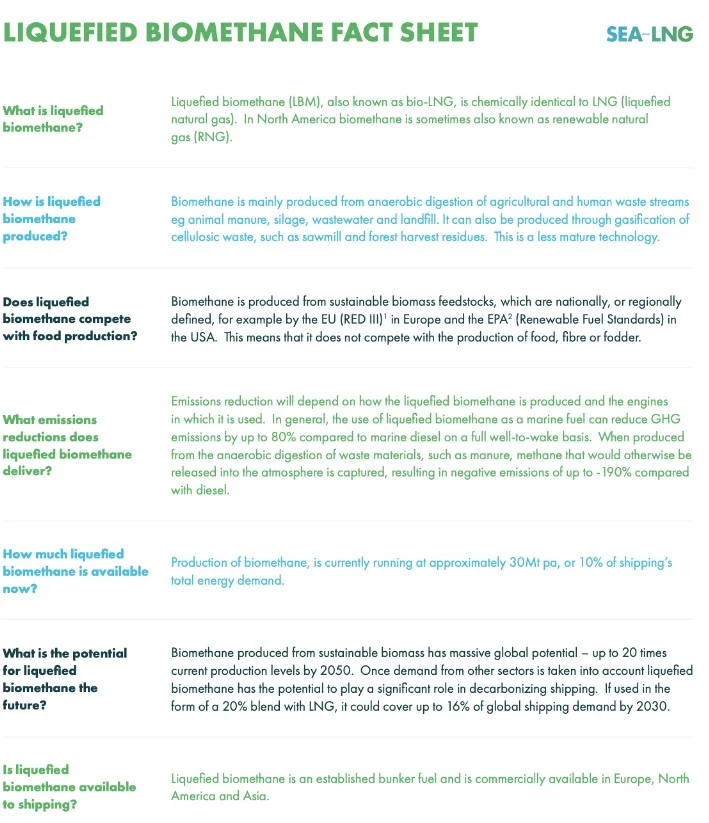SEA-LNG new report, titled “Decarbonising Shipping: Fueling The Net Zero Transition Through The Liquefied Methane Pathway,” explores key facts about liquefied methane, its pathway to support net-zero GHG emissions in shipping, and potential synergies with other emissions reduction measures. This is especially pertinent as new EU laws could facilitate the widespread adoption of liquefied methane vessels and infrastructure.
The shipping industry recognizes that it must decarbonize the fuels it uses to support global efforts to combat climate change. Time is of the essence, and action is needed today. Currently, the majority of ships (>95%) use heavy fuel oils (HFO), diesel (as Marine Gas Oil or Marine Diesel Oil) onboard, or Very Low Sulphur Fuel Oil (VLSFO). Various renewable fuels have been proposed as possible replacements to support climate neutrality by 2050; however, rapidly scaling their deployment can face significant technical and economic challenges.
Liquefied fossil methane (known as liquefied natural gas or LNG) is today developing as the principal alternative marine fuel, with wide availability through existing and expanding global bunkering infrastructure and proven vessel technologies. It starts decarbonizing shipping today and provides a competitive pathway to a net-zero greenhouse gas (GHG) emission future using liquefied biomethane and liquefied e-methane.
This briefing explores key facts about liquefied methane, its pathway to support net-zero GHG emissions in shipping, and potential synergies with other emissions reduction measures. These are:
- Cutting emissions today: liquefied methane can offer up to 23% GHG emissions reductions.
- Clear pathway to support net zero.
- Already a greener choice that provides health benefits today.
- Ready for immediate implementation with existing infrastructure.
- The challenge of methane slip is being overcome.
- Proven safe alternative fuel option.
- Financially attractive decarbonization pathway.
Three Key Asks
Recently adopted EU laws will support the widespread adoption of liquefied methane vessels and infrastructure in the coming years to decarbonize shipping. To successfully achieve decarbonization and competitiveness of European maritime transport, our 3 key asks for the next Commission and European Parliament mandate are:
- Prioritize EU funding for low and zero carbon maritime fuels production, including liquefied biomethane and e-methane.
- Ensure European industries and maritime transport have access to sufficient amounts of biomethane and e-methane irrespective of where it has been produced (inside or outside EU).
- Uphold technology neutrality and performance-based decarbonization targets. Policymakers should set clear targets and enable business and industry to choose the most efficient way of reaching them.
Key Benefits of Liquefied Methane for Decarbonizing Shipping
1. Cutting emissions today: Liquefied methane can offer up to 23% GHG emissions reductions
Today, liquefied methane in its fossil version, also known as LNG, can reduce total GHG emissions, including any methane slip, on a ship by up to 23% on a full lifecycle, Well-to-Wake basis, compared to the current main marine fuels. This is why liquefied methane presents an opportunity for shipping to reduce GHG emissions now, despite the low availability at present of liquefied biomethane and very low availability of liquefied e-methane.
2. Clear pathway to support net zero
To reach net-zero GHG emissions by 2050, maritime transport needs to use lower and net-zero emission fuels. For liquefied methane, there is a clear pathway and transition to net-zero.
Starting with liquefied fossil methane, shipping can transition to net-zero emissions by gradually adding net-zero liquefied biomethane and net-zero liquefied e-methane to the fuel mix. All fuels on the methane pathway can be blended at any ratio without changes to infrastructure, meaning they can be introduced as soon as they become available at sufficient scale. Vessels fueled by liquefied methane have accelerated within a decade from 36 to nearly 500 in operation, with more than 500 on the order book. This shows the huge potential for decarbonization via the liquefied methane pathway.
3. Already a greener choice which provides health benefits today
Liquefied methane in its fossil version (LNG) offers lower GHG emissions from a lifecycle perspective than not only heavy fuel oils or diesel but also methanol and ammonia in their fossil versions. It also emits virtually no sulfur oxides (SOx) and particulate matter (PM). Compared to existing heavy marine fuel oils, liquefied methane can, depending on the engine technology used, reduce nitrogen oxide (NOx) emissions by up to 95%.
4. Ready for immediate implementation with existing infrastructure
Even though there is still a way to go before liquefied biomethane becomes available at scale, it is increasingly available for ships in Europe, sourced sustainably, usually from waste, without competing with food production. While other fuels require new infrastructure investments, liquefied biomethane can utilize existing natural gas and LNG infrastructure, existing engines, and existing facilities. Also, projects are underway, which will see the delivery of liquefied e-methane within two years, giving a head start towards emission-free shipping using the liquefied methane pathway.
5. The challenge of methane slip is being overcome
Methane slip is frequently misconstrued in the public debate as a fatal flaw of LNG-fueled engines. The reality is that it is a recognized challenge which industry is well on the way to solving. The technology to virtually eliminate methane slip from ship engines is very promising and is being piloted on vessels today. For instance, high-pressure dual-fuel engine technologies already exist with virtually no methane slip, and for low-pressure engines where it remains an issue, continuing innovation by engine manufacturers has resulted in levels of methane slip falling more than four-fold over the past 25 years. With constant advances in technology, we are confident the issue of methane slip can be solved within a decade.
6. Proven safe alternative fuel option
Liquefied methane offers a safe, proven, and practical pathway to decarbonization. It has been used operationally for over 60 years without any major safety incidents at port or at sea. During this time, significant expertise has been developed in the safe handling and bunkering of liquefied methane, and rigorous training standards for seafarers and shoreside crew have been developed.
7. Financially attractive decarbonisation pathway
Liquefied methane in its fossil form kick-starts the maritime decarbonization process with GHG emissions reductions of up to 23%. Liquefied biomethane is the lowest-cost bio-derived fuel. It can simply be dropped into existing LNG-fueled vessels and fossil LNG infrastructure, avoiding much of the investment in new, expensive supply chains. The same is true of liquefied e-methane, which is produced from green hydrogen, the common feedstock which makes up 70%-80% of the costs of all e-fuels, such as e-methanol and e-ammonia. Liquefied biomethane and e-methane have almost twice the energy density of their methanol and ammonia counterparts, meaning they take up much less space on the vessels they fuel, leaving more space for revenue-generating cargo.

Source SEA-LNG

